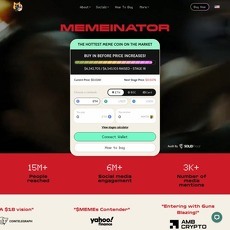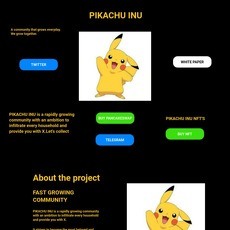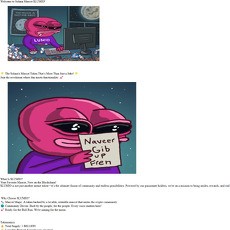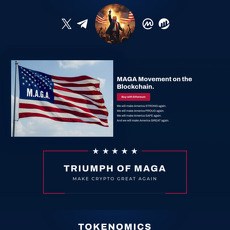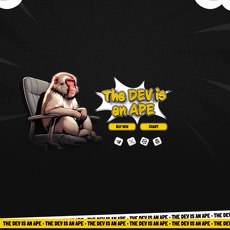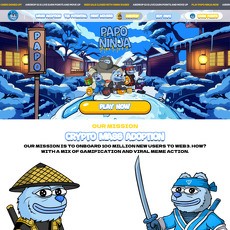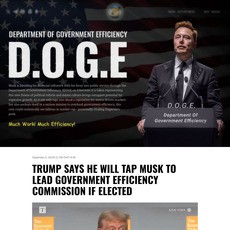Silly Dragon Review
Silly Dragon
sillydragon.co
If your website is on the scam list and you think that you are not a scammer, contact us. After you provide us with all the proof that you are in Crypto World with good intentions, we will delist you. Usually, you get in this category because you are hiding your team, you have a bad reputation(you are tricking, deceiving, scamming people), and you haven't got a written project whitepaper or is a shitty one....
Their Official site text:
Introduction
Silly Dragon Emerged As More Than Just A Concept During Halloween 2023, When Anatoly Yakovenko, Co-Founder Of Solana, Welcomed Conference Attendees Dressed In A Costume Embodying The Silly Dragon.
This Playful But Significant Moment Marked The Official Introduction Of This New Version -Silly Dragon-, A Character Destined To Leave A Lasting Imprint On The Blockchain.
Year of Dragon 2024
On 2023, November 8, Anatoly posts on his x account "The year of the silly dragon" has infused a fresh and playful energy into the solana narrative. as we approach 2024, often associated with the dragon in various cultural zodiacs, anticipation builds for what narratives and innovations might unfold around the silly dragon. this playful symbol could very well become a catalyst for new, creative initiatives and community engagement, adding an intriguing layer to the evolving solana story.
Ethereum X Solana
In a Dec. 25 tweet, Yakovenko, co-founder of Solana and CEO of Solana Labs playfully suggested that Solana could be considered an Ethereum layer-2 (L2) solution through its Wormhole eigenlayer. This statement was part of a tongue-in-cheek response to a tweet listing various L2 solutions like Arbitrum, Aztec, and Polygon. He quipped: “Solana is ethereum! Solana is an ethereum L2 through the wormhole eigenlayer. Once danksharding is scaled up no one is going to stop you from submitting all the Solana blocks into some data validating bridge contract on ethereum.”
Disclaimer: SILLY DRAGON IS A MEME COIN ON THE ETHEREUM BLOCKCHAIN. THIS IS NOT INVESTMENT ADVICE. THE COIN IS FOR ENTERTAINMENT AND EDUCATIONAL PURPOSES ONLY. THE FOUNDERS ARE NOT LIABLE FOR ANY LOSSES OR DAMAGES. THE MARKET IS VOLATILE; INVEST AT YOUR OWN RISK. NO GUARANTEES OF PROFIT OR VALUE RETENTION. RESEARCH THOROUGHLY BEFORE INVESTING. BY BUYING, YOU ACKNOWLEDGE THE RISKS INVOLVED. FOUNDERS HAVE NO OBLIGATION TO UPDATE INFORMATION. LAWS VARY BY JURISDICTION; COMPLY WITH LOCAL REGULATIONS. THIS DISCLAIMER IS SUBJECT TO CHANGES WITHOUT NOTICE.
The SILLY AI
SILLY GPT is an Artificial Intelligence (AI) model based on the foundational principles of GPT (Generative Pre-trained Transformer). This AI system is specifically designed to assist with applications related to cryptocurrency and blockchain. By understanding the underlying principles of GPT, users can gain an understanding of how SILLY GPT works and the kinds of tasks it can accomplish.
This guide will provide an overview of SILLY GPT, an advanced Artificial Intelligence (AI) model designed to aid with activities related to cryptocurrency and blockchain. It will explain the concepts underlying GPT, including its functions and capabilities, as well as how to utilize it effectively. This guide is ideal for developers, researchers, and other individuals with an interest in AI looking to gain a comprehensive understanding of SILLY GPT and its capabilities.
SILLY GPT Model:
Machine Learning
SILLY GPT is a highly advanced AI model that has been improved upon through significant machine-learning open-source model training. It has evolved into the powerful AI model that it is today.
Language Modeling
Our Machine Learning Engineers trained GPT on a dataset of comprehensive details related to Blockchain Technologies, Crypto, Technical Analysis, Security Audits, and many more categories from this domain. This comprehensive dataset enabled us to generate a high number of features in our offerings.
Transformer - Self Attention & Acyclic Directed Graphs
It works by utilizing self-attention to encode the contextual relationships between words, which allow it to produce text that captures both the context of the current sentence and the meaning of the original text. SILLY GPT is a powerful text generation tool that can quickly generate coherent, realistic text based on the input provided.
Generative AI
SILLY GPT is a generative AI model that is capable of producing information in response to an input known as a "prompt" that is related or related to Crypto. This allows it to answer any user questions on these topics.
Context Awareness
Contextual awareness is the embodiment of all the nuances of human learning, encompassing the questions of "who", "where", "when" and "why" that influence human decisions and behavior.
GPT-4 is an advanced multimodal model that not only takes text or image inputs but also outputs text. Its broad general knowledge and powerful reasoning capabilities enable it to solve more complex problems with greater accuracy and efficiency than ever before. Moreover, GPT-4 has been optimized for chatbots but it is also effective for traditional completion tasks.
SILLY AI System
By providing diverse DeFi offerings, SILLY intends to promptly establish a robust presence in the DeFi market by offering exceptional use cases. This approach distinguishes it from other DeFi cryptocurrency projects and enables it to set itself apart.
---
Disclaimer: SILLY DRAGON IS A MEME COIN ON THE ETHEREUM BLOCKCHAIN. THIS IS NOT INVESTMENT ADVICE. THE COIN IS FOR ENTERTAINMENT AND EDUCATIONAL PURPOSES ONLY. THE FOUNDERS ARE NOT LIABLE FOR ANY LOSSES OR DAMAGES. THE MARKET IS VOLATILE; INVEST AT YOUR OWN RISK. NO GUARANTEES OF PROFIT OR VALUE RETENTION. RESEARCH THOROUGHLY BEFORE INVESTING. BY BUYING, YOU ACKNOWLEDGE THE RISKS INVOLVED. FOUNDERS HAVE NO OBLIGATION TO UPDATE INFORMATION. LAWS VARY BY JURISDICTION; COMPLY WITH LOCAL REGULATIONS. THIS DISCLAIMER IS SUBJECT TO CHANGES WITHOUT NOTICE.
Large Language Models (LLMs)
What are Large Language Models (LLMs)?
At its core, a Large Language Model (LLM) is a machine learning model trained on vast amounts of text data. The "large" in its name refers to the enormity of its architecture and the vastness of training data it consumes. These models learn patterns, nuances, and complexities of the languages they're trained on, allowing them to generate human-like text based on the patterns they've observed.
How Do LLMs Work?
LLMs operate based on patterns in data. When trained on vast datasets, they become adept at recognizing intricate patterns in language, enabling them to predict the next word in a sentence, answer questions, generate coherent paragraphs, and even mimic certain styles of writing.
The strength of LLMs comes from the billions of parameters they contain. These parameters adjust during training, helping the model better predict text based on its input.
Applications of LLMs
Due to their impressive capabilities, LLMs have a wide range of applications:
Content Generation: LLMs can produce articles, stories, poems, and more.
Question Answering: They can understand and answer queries with considerable accuracy.
Translation: While not their primary design, LLMs can assist in language translation.
Tutoring: They can guide learners in various subjects by providing explanations and answering questions.
Assisting Developers: LLMs can generate code or assist in debugging.
Conversational Agents: Powering chatbots for customer service, mental health, and entertainment.
The Potential and Challenges
Potential: The expansive knowledge and adaptability of LLMs make them invaluable across sectors, from education and entertainment to research and customer support. Their ability to generate human-like text can save time, offer insights, and even foster creativity.
Challenges: LLMs, though powerful, aren't infallible. They can sometimes produce incorrect or biased information. Understanding their limitations and using them judiciously is crucial. Ensuring fairness and accuracy while reducing biases is a priority in the ongoing development of LLMs.
Conclusion
Large Language Models, with their immense capabilities, are reshaping our interaction with technology. They bridge the gap between human communication and computational understanding. As they continue to evolve, the potential applications and benefits of LLMs in our daily lives and industries are boundless. However, as with any technology, a balanced and informed approach ensures that we harness their potential while being aware of their limitations.
Text to Image Models (TTIMs)
What are Text to Image Models (TTIMs)?
Text-to-image models, commonly known as TTIMs, represent an innovative intersection of natural language processing and computer vision in artificial intelligence. TTIMs take descriptive text as input and generate a corresponding visual representation or image. This transformation from textual description to visual imagery showcases the confluence of understanding language and creating visual content.
How Do TTIMs Operate?
TTIMs harness the capabilities of both language models and image generation techniques. Here's a simplified breakdown:
Textual Understanding: The model first interprets the textual input, breaking it down into key descriptors and themes.
Feature Mapping: The understood text is then mapped to visual features. This might involve recognizing shapes, colors, patterns, or spatial relationships described in the text.
Image Generation: Using advanced neural networks, especially Generative Adversarial Networks (GANs), the model creates an image based on the mapped features. Based on the textual description, it aims to make this image as accurate and detailed as possible.
Applications of TTIMs
TTIMs have a burgeoning array of applications in the modern digital landscape:
Content Creation: For artists, designers, and content creators, TTIMs can help visualize ideas or concepts described in text.
Education: They can aid in creating visual aids for teaching based on textual descriptions or instructions.
Entertainment: Imagine reading a story and having visuals generated on the fly, enhancing the storytelling experience.
Prototyping: In design and development, quickly visualizing concepts described in meetings or brainstorming sessions.
Accessibility: Assisting visually impaired individuals by creating visual content from textual descriptions which can then be further described or transformed into tactile experiences.
Potential and Limitations
Potential: TTIMs can revolutionize sectors like design, media, and education by streamlining the process of visual creation and aiding in better visualization of abstract concepts.
Limitations: Current TTIMs, while impressive, may not always produce perfectly accurate or high-resolution images. The generated visuals might miss nuanced details or interpret ambiguous text in unexpected ways. Training data and the specificity of textual input play a crucial role in the accuracy of the generated image.
In Conclusion
Text to Image Models stand as a testament to AI's leaps in bridging the gap between language and vision. They promise a future where ideas, stories, and descriptions can be instantly visualized, opening doors to new ways of communication, creation, and understanding. As the technology behind TTIMs continues to mature, we can expect even more accurate and detailed visual translations of our textual expressions.


